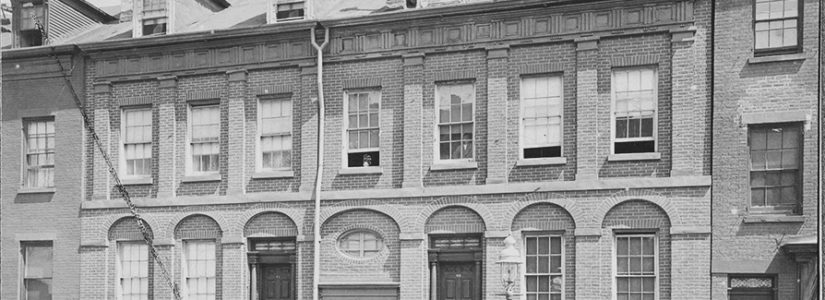
New to Archives: Frank Cousins Collection & Carnegie Hall’s Digital Archives Project!
May 14, 2014
Article from the Spring 2014 Newsletter
The Public Design Commission of the City of New York (formerly the Art Commission) has digitized a small but notable collection of photographs important to the history of preservation in New York City. In 1913 the agency commissioned photographs of approximately 50 buildings that were deemed architecturally and historically significant. Several were chosen for documentation because they were thought to be in danger of demolition, and in fact many were subsequently destroyed. The commission’s objective was to ensure that future generations would at least have access to these structures in photographic form. The project photographer was Frank Cousins (1851-1925), an expert on American colonial architecture who is credited with making architectural photography a specialty discipline. Due to his expertise, Cousins likely had some input on the selection of buildings to be documented. This series of photographs is significant as one of the City’s earliest official efforts to document its architectural heritage.
The Frank Cousins Collection includes images of residential, commercial, and religious structures dating to the 18th- and early 19th-centuries throughout Manhattan, Brooklyn, the Bronx, and Staten Island. Several of the surviving buildings are now house museums, including the Morris-Jumel Mansion and the Lefferts Historic House.Other recognizable surviving landmarks include Colonnade Row on Lafayette Street and the Rectory of the Shrine of St. Elizabeth Ann Seton near Battery Park. But many of the buildings captured in these photographs have not survived. St. John’s Chapel on Varick Street was torn down in 1918 for a controversial road-widening scheme, and the Rhinelander Mansions on Washington Square North were replaced with an apartment building in 1951, not without much opposition. A variety of other lesser-known colonial farmhouses and townhouses that were documented in this project have likewise met the wrecking ball, including the row of private homes pictured below, built ca. 1820 and named by American Architect magazine as the “best masterpieces of our old city homes” in 1915. Luckily, the photographs survive, and the digital scans include both the prints themselves and the short, handwritten descriptions on the reverse of each print that relay interesting snippets of history about each structure. The Frank Cousins Collection may be accessed from “The Archive” tab on the Public Design Commission’s website.
In 2012, Carnegie Hall embarked upon its Digital Archives Project, a multi-year initiative to conserve and digitize a significant portion of the Hall’s vast historic collections. This project will ensure that the Hall’s distinguished legacy is preserved for future generations. Although Carnegie Hall did not establish a formal archive until 1986, a vigorous effort was made in subsequent years to collect materials related to the building’s history over the preceding century. The Carnegie Hall Archive now contains thousands of concert programs, posters and fliers, musical manuscripts, autographs, administrative files, and architectural drawings that tell the story of the Hall since it opened in 1891. Included within the collection are materials related to the successful effort to save Carnegie Hall from demolition in the early 1960s, led in large part by renowned violinist Isaac Stern.
The Carnegie Hall Archive obtained a grant to perform an assessment of their entire collection and then commenced digitization in 2012. In the first year of the project, 2,000 video and audio recordings and 3,700 programs were digitized. Textual records of 15,000 events that occurred in Carnegie Hall from 1891 to 1950 are now available on the Hall’s website. Of special interest to architects and preservationists is an early product of this project: the restoration and digitization of a detailed cross-section drawing of the Hall prepared in 1889 by the building’s architect, William Burnet Tuthill. It is a rare surviving example of an original design drawing by Tuthill, whose papers were lost after he died in 1929. Also of note is the digitization of the documentary film The 28-Week Miracle, which chronicles the 1986 restoration of the Hall’s interior, including interviews with Stern, then-Mayor Ed Koch, and restoration architect James Polshek. Stay updated on the Digital Archives Project by visiting www.carnegiehall.org.
The Library of Congress has completed digitizing its collection of over 400 panoramic postcards dating from the late-19th and early-20th centuries. The postcards, which were filed with the Library of Congress to establish copyright, show a wide range of parklands, townscapes, historic sites, and buildings from throughout the United States. One of the highlights of this collection is an 1850 panorama of New York City drawn from St. George, Staten Island. In the foreground is the St. George quarantine station, which was destroyed in 1858. The background shows New York harbor from the unspoiled New Jersey Palisades to the low, steeple-laden skylines of Manhattan and Brooklyn. Another interesting panorama in the collection is a 1908 postcard showing a baseball game at the former Polo Grounds in Upper Manhattan, revealing not only the old stadium but also a train on the adjacent elevated railroad track (part of the Ninth Avenue El) and the buildings on higher ground overlooking it, including the Morris-Jumel Mansion. Like other collections of historic photos and drawings, this collection is of use to preservationists and historians seeking documentation of historic views.
To view images from the collection, visit the Library of Congress and search for Lot 14058.